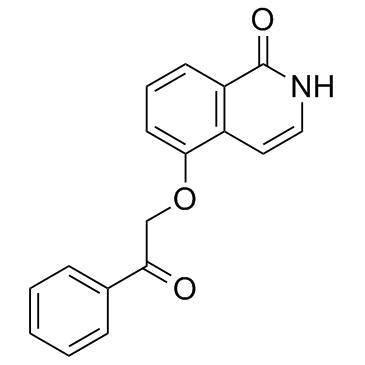1048371-03-4
| Name | 5-phenacyloxy-2H-isoquinolin-1-one |
|---|---|
| Synonyms |
5-(2-Oxo-2-phenylethoxy)isoquinolin-1(2H)-one
1(2H)-Isoquinolinone, 5-(2-oxo-2-phenylethoxy)- UPF 1069 5-(2-Oxo-2-phenylethoxy)-1(2H)-isoquinolinone |
| Description | UPF 1069 is a PARP inhibitor, with IC50s of 8 and 0.3 μM for PARP-1 and PARP-2, respectively. |
|---|---|
| Related Catalog | |
| Target |
PARP-2:0.3 μM (IC50) PARP-1:8 μM (IC50) |
| In Vitro | UPF 1069 (Compound 55) is a PARP inhibitor, with IC50s of 8 and 0.3 μM for PARP-1 and PARP-2, respectively[1]. UPF 1069 (1 µM) reduces the residual PARP activity by approximately 80% of PARP-1-deficient fibroblasts, but only slightly inhibits the enzymic activity in wild-type fibroblasts. UPF 1069 (0.1-1 µM) markedly enhances CA1 hippocampal damage. UPF 1069 (10 µM) also exacerbates oxygen-glucose deprivation (OGD) damage in organotypic hippocampal slices. However, UPF 1069 alleviates the damage cuased by OGD in mixed cortical cell cultures, shows a potent neuroprotective activity both at a concentration (1 µM) selectively acting on PARP-2 and at a concentration (10 µM) inhibiting both PARP-1 and PARP-2 activities[2]. |
| Kinase Assay | PARP activity is evaluated by utilizing commercially available recombinant bovine PARP-1 and mouse PARP-2. Briefly, the enzymatic reaction is carried out in 100 µL of 50 mM Tris-HCl (pH 8.0) containing 5 mM MgCl2, 2 mM dithiothreitol, 10 µg sonicated calf thymus DNA, 0.2 µCi [adenine-2,8-3H]NAD and recombinant enzyme PARP-1 or PARP-2 (0.03 U per sample). Different concentrations of the putative inhibitors are added, and the mixture is incubated for 1 h at 37°C. The reaction is terminated by adding 1 mL of 10% trichloroacetic acid (w/v) and centrifuged. Pellets are then washed twice with 1 mL of H2O and resuspended in 1 mL of 0.1 M NaOH. The radioactivity incorporated from [adenine-2,8-3H]NAD into proteins is evaluated by liquid scintillation spectrometry[2]. |
| References |
| Density | 1.3±0.1 g/cm3 |
|---|---|
| Boiling Point | 570.3±50.0 °C at 760 mmHg |
| Melting Point | 166-168 °C |
| Molecular Formula | C17H13NO3 |
| Molecular Weight | 279.290 |
| Flash Point | 298.7±30.1 °C |
| Exact Mass | 279.089539 |
| PSA | 59.42000 |
| LogP | 2.22 |
| Vapour Pressure | 0.0±1.6 mmHg at 25°C |
| Index of Refraction | 1.618 |
| Storage condition | Store at RT |
